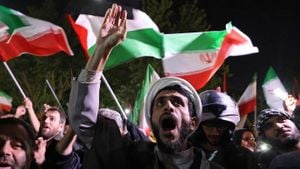Military aid to Ukraine has become the focal point of discussions surrounding the Russian invasion, especially since the escalation of hostilities beginning with Russia's full-scale military moves against Ukraine back in 2022. Countries across the globe have stepped up to provide support, which includes weapons, logistics, and humanitarian assistance. This infrastructure not only seeks to bolster Ukraine’s defense capabilities but also aims to disrupt Russian plans for territorial expansion, indicating the importance of international solidarity.
The United States has emerged as one of Ukraine's primary supporters, significantly increasing its military aid packages over the past three years. This includes advanced artillery systems, air defense initiatives, and more recently, discussions over modernized armored vehicles. Reports indicate the U.S. has sent billions of dollars worth of military hardware, which Ukrainian forces have integrated effectively on the battlefield, matching tactics with the new equipment.
Meanwhile, European nations have also committed considerable resources. Countries like Germany and France have made headlines for their decisions to provide tanks and other heavy weaponry. Germany, particularly, faced scrutiny earlier for its hesitance to send arms, but under growing pressure, particularly from Eastern European neighbors, it has altered its stance and upped its contributions.
Logistical challenges persist, though. Sourcing the necessary equipment and ensuring timely delivery remains complex, as supply lines are threatened by Russian advances, particularly around contested regions like Donetsk and Luhansk. Experts point to the need for more streamlined logistic frameworks to aid rapid deployment to Ukrainian forces engaged on various fronts.
Recent disclosures highlight various diplomatic negotiations among NATO allies aimed at coordinating their efforts more effectively, as different countries offer different types of support. Air defense systems and advanced artillery support are being prioritized, as these components are seen as pivotal to countering Russia's aerial and ground assaults.
Another layer complicates these dynamics: intelligence sharing. The successful deployment of military aid often depends on actionable intelligence from various sources. This information is pivotal for Ukraine's armed forces to make informed decisions on the battlefield.
Among those closely monitoring the operational strategies is Ukraine’s Security Service (SBU), which has recently made headlines itself due to security concerns from infiltration attempts impacting military logistics. Their recent detainment of UN aid workers suspected of espionage for Russian intelligence highlights the stakes involved. The individual, detained for allegedly relaying intelligence on the Ukrainian military's positions, serves as a sobering reminder of the challenges Ukraine faces not just from military force but also from espionage and internal threats.
The impact of these geopolitical maneuvers reaches out beyond military gains. The humanitarian crises resulting from the conflict have forced countries to rethink their aid strategies. The UN and various NGOs continue to operate under precarious conditions, distributing resources amid conflict zones, striving to provide food, shelter, and medical care to millions displaced by the fighting.
At the same time, domestic politics across these allied nations factor significantly. Political leaders navigate pressures from constituents to provide adequate support to Ukraine, balanced with fears of escalation with Russia. There’s also concern over public opinion, which varies widely—some citizens call for armed support, viewing it as necessary to counter Russia, whereas others fear the entanglement of countries like the U.S. and its allies in yet another prolonged military conflict.
On the technological front, Ukraine has seen the integration of cutting-edge defense systems, partly funded through military aid. Drones and intelligence warfare tactics have become mainstays for Ukrainian troops. They've adapted to utilize these technologies to immense effect, conducting operations against Russian forces, which were caught off guard due to the rapid shifts and modifications of the conflict’s parameters.
The collaborative efforts behind military aid are not without their hurdles. Continual assessments are needed to determine the adequacy of support, especially with fluctuated front lines and dynamic military strategies being employed by both sides. Continuing dialogues among allies point to the necessity of agile response strategies to adjust aid based on real-time needs.
Further complicators include the potential for international sanctions to influence the logistics of military aid. The Western response has heavily relied on sanctioning Russia, affecting its military supply chains and available resources. This adds another dimension to the discussions about how to best channel support to Ukraine without inadvertently giving Russia leverage.
On the ground, coordination with Ukrainian forces remains pivotal. U.S. and NATO contractors are actively involved, providing training and operational planning skills aimed at maximizing the effectiveness of this military hardware. This collaborative effort hinges upon not only the logistical capabilities but recovery and maintenance of equipment once deployed.
Looking to the future, experts are cautious but hopeful. The influx of support could prove significant if coordinated properly, with some analysts underscoring the value of continued financial backing as the war showcases the dire need for sustainable military solutions.
Colossal international pressure is mounting as well on Russian forces, with many urging for continued sanctions and the pressing of military aid to Ukraine as necessary to curtail Moscow's aggressive maneuvers. The conflict has returned to the forefront of global discussions, with leaders faced with pivotal decisions influencing not only the war but also regional stability across Europe.
Military aid shipments, dynamic troop deployments, and the adaptation of tactics are all part of this complex and multifaceted endeavor. It's evident now, as Ukraine battles external aggression alongside internal threats, the path to stability is ridden with challenges, yet there's substantial resolve among allies to support Ukraine's endeavors.
The international verdict on military aid's effects on Ukraine's standing continues to evolve, yet unequivocally, it plays a monumental role. From tactical responses to humanitarian efforts, aiding Ukraine remains volatile yet steadfastly compelling as the world looks onward.



